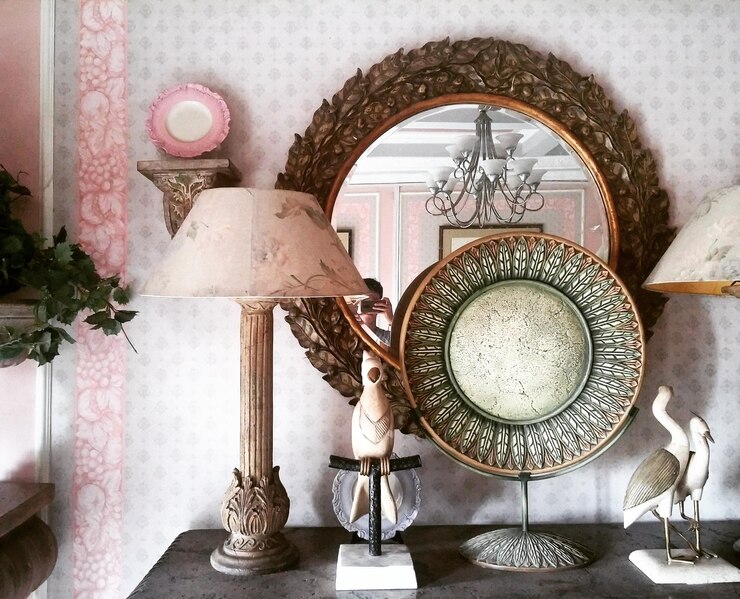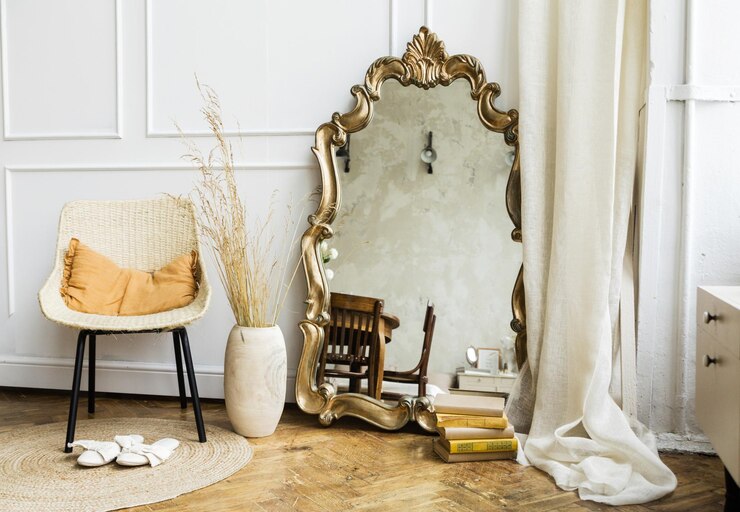Antiqued mirrors have become a staple in interior design, adding charm and warmth that few other decorative items can match. With their aged finishes and unique patinas, these mirrors are far more than functional items; they’re conversation starters, mood-setters, and timeless style enhancers. Whether gracing a hallway, creating a statement in a living room, or adding elegance to a bedroom, an antiqued mirror offers a beautiful blend of vintage aesthetics and modern versatility.
For those intrigued by the character of antiqued mirrors or those exploring ways to incorporate them into a design plan, here’s a deep dive into the allure, functionality, and decorative potential of these elegant pieces.
Understanding Antiqued Mirrors: What Makes Them Unique?

An antiqued mirror, often called a distressed or vintage mirror, is designed to mimic the look of aged glass. Unlike a conventional mirror with a flawless, clear surface, antiqued mirrors have been treated to create a weathered effect, often featuring small spots, faded areas, or a patina finish that gives the glass a unique texture and look. This distinctive finish often recalls the elegance of eras past, when mirrors were handmade and crafted with various techniques.
Antiquing a mirror can involve several processes, including applying acid treatments, distressing the glass, or using metallic finishes. This results in an item that combines art and function, lending character to the room in which it resides.
The History of Antiqued Mirrors: A Timeless Tradition
Mirrors have been a part of human history for centuries, dating back to ancient civilizations like Egypt and Mesopotamia. In early history, polished metals like copper and bronze served as the first reflective surfaces. However, the development of glass mirrors, a more modern innovation, began in Venice during the Renaissance. Venetian craftsmen perfected glassmaking and invented various techniques for creating clear and reflective surfaces.
As mirrors became more accessible, they evolved beyond mere tools for self-reflection. Antique mirrors quickly became cherished decorative items, often featuring ornate frames and unique finishes. In the centuries since, their style has persisted and evolved, with antiqued mirrors today drawing inspiration from these classical designs. The aged, distressed finishes of antiqued mirrors represent a nod to this rich history, evoking both artistry and nostalgia.
Different Styles of Antiqued Mirrors: From Baroque to Modern Vintage
Antiqued mirrors come in various styles, each offering its charm and functionality. Here are some popular types:
Baroque Antiqued Mirrors
Inspired by the grandeur of the Baroque period, these mirrors often feature elaborate carvings, gilded frames, and intricate detailing. The distressed glass, combined with the ornate frame, makes Baroque mirrors ideal for adding drama and opulence to any room.
Industrial Antiqued Mirrors
Industrial-style antiqued mirrors have a more rugged, minimalist appeal. Featuring metal frames, often in darker finishes like black or brass, they fit well in modern or urban-inspired spaces. The aged patina on the mirror glass gives a nod to the past while maintaining a contemporary aesthetic.
Vintage French Mirrors
These mirrors reflect the elegance and romance of French design, often with softer curves, floral accents, and pastel finishes. The antique patina on the glass creates a subdued reflection, perfect for adding a touch of Parisian charm to a bedroom or living space.
Modern Antiqued Mirrors
For those who appreciate a blend of old and new, modern antiqued mirrors offer clean lines with a distressed mirror finish. These are often simpler in design and fit well in minimalist or transitional spaces, where the aged look of the mirror contrasts beautifully with modern decor.
Why Choose an Antiqued Mirror? The Charm and Practicality of Distressed Glass
Antiqued mirrors aren’t just for vintage enthusiasts; their appeal spans a broad range of design preferences. Here are some reasons why they are a sought-after element in interior decor:
- Creates Visual Depth: The distressed nature of the glass subtly diffuses light, adding depth and interest to a room. This effect makes spaces feel more layered and luxurious.
- Versatile Aesthetic Appeal: Antiqued mirrors complement various design styles, from rustic and industrial to bohemian and modern. They serve as functional art pieces that can blend seamlessly or stand out.
- Hides Imperfections: Unlike regular mirrors, which show smudges or fingerprints, the distressed surface of an antiqued mirror masks minor blemishes, making it easier to maintain.
- Adds Warmth and Character: Aged mirrors have a nostalgic quality, creating a cozy and lived-in atmosphere. They can soften modern spaces and add warmth to minimalist or industrial designs.
Incorporating Antiqued Mirrors into Your Home Décor
In the Living Room
In a living room, an antiqued mirror can become a focal point. Place a large mirror above a fireplace or use multiple smaller mirrors in a gallery wall arrangement. This adds interest and texture while helping reflect light throughout the space, creating a warm, inviting ambiance.
In the Bedroom
Adding an antiqued mirror to a bedroom can instantly increase its charm. Consider a full-length antiqued mirror in a French or Baroque style beside a vanity or closet. The softened reflection makes the space feel more relaxed and tranquil, ideal for a bedroom setting.
In the Dining Room
Dining rooms benefit from the elegance of an antiqued mirror. Placing a large mirror on one of the walls can make the room appear larger and grander. The distressed glass adds sophistication, and the warm tones of the mirror help set a welcoming tone for family gatherings.
In Entryways and Hallways
Entryways are perfect for antiqued mirrors, as they help create a strong first impression. A well-placed mirror can make narrow spaces appear wider, adding both function and beauty. Paired with a console table or a set of vintage hooks, an antiqued mirror can turn a simple entryway into a statement area.
Caring for Your Antiqued Mirror: Tips for Longevity
While an antiqued mirror’s aged appearance makes it durable, following some care tips can ensure it stays beautiful for years:
- Use a Soft Cloth: Avoid harsh materials that might scratch the delicate surface. Opt for a soft, microfiber cloth for cleaning.
- Avoid Harsh Chemicals: Regular mirror cleaners may damage the patina or finish on antiqued mirrors. Use a gentle, diluted soap solution for cleaning.
- Keep Away from Humidity: Prolonged exposure to moisture can accelerate the aging process of an antiqued mirror, so avoid placing them in humid spaces like bathrooms without proper ventilation.
- Frame Maintenance: For mirrors with wooden or metal frames, occasional polishing or waxing can help maintain the frame’s finish.
Antiqued Mirror DIY: How to Create Your Own Vintage Mirror Look
If you’re crafty, creating your own antiqued mirror can be a rewarding DIY project. Here’s a simple guide to achieving that vintage look:
- Prepare the Mirror: Start with a clean mirror. Use masking tape to protect the edges if it has a frame.
- Apply a Mirror Stripper: Use a mirror or paint stripper on the back of the mirror to distress areas of the reflective coating. This will create spots and imperfections.
- Add Distressing Solution: Spray a mix of water and vinegar onto the glass to create tiny droplets that mimic natural aging.
- Seal the Mirror: Once you’re happy with the look, seal the back with a clear sealant to protect the finish. Allow it to dry before using.
With a few supplies and a bit of patience, you can create a personalized antiqued mirror to suit your space perfectly.
FAQs
How do I know if an antiqued mirror is authentic?
Authentic antique mirrors usually have handmade frames, patina, or distressing that doesn’t appear uniform. Older mirrors may also have imperfections from historical manufacturing processes.
Can antiqued mirrors work in a modern home?
Absolutely. Antiqued mirrors add warmth and visual interest, making them ideal for balancing clean lines in modern interiors.
What rooms are best for antiqued mirrors?
Antiqued mirrors suit any room. They can create a statement in living rooms, add elegance to bedrooms, and even enhance dining rooms and entryways.
Are antiqued mirrors difficult to maintain?
No, antiqued mirrors are relatively low-maintenance since their distressing can hide minor imperfections. Use a gentle cleaning solution and a soft cloth for best results.
Is there a difference between antiqued and vintage mirrors?
“Antiqued” mirrors are often newly manufactured pieces treated to look aged, while “vintage” mirrors are genuinely old pieces that have aged naturally over time.
Can I make my own antiqued mirror?
Yes, with the right supplies, it’s possible to create an antiqued look on a mirror at home. Follow steps like applying mirror stripper and distressing solutions to get the look.
Conclusion
An antiqued mirror is more than just a functional piece; it’s an artwork that adds depth, character, and historical elegance to any room. From rustic to modern interiors, these mirrors adapt beautifully to different design aesthetics, offering a sense of warmth and nostalgia. Whether you purchase an antique or create a DIY piece, an antiqued mirror can transform your space, adding a touch of timeless elegance that captures the charm of











